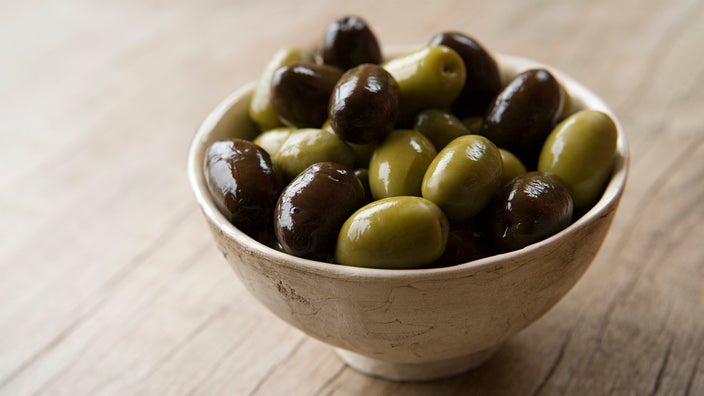
Are Olives Good for You? Health Benefits and Nutrition Overview
Key takeaways:
Olives are a nutritious food for most people because of their healthy fats, fiber, and nutrients like vitamin E.
Olive oil is extracted from olives and has been shown to support heart health. It helps prevent heart disease, lower cholesterol, and lower blood pressure.
If you’re watching your sodium intake, try to limit your olive intake to about 5 to 10 olives per day since they’re high in salt. Consuming olive oil is one way to get some of the health benefits of olives without the salt.
Table of contents

Olives are a staple of the Mediterranean diet, which is known to help reduce the risk of heart disease, Type 2 diabetes, and some types of cancer.
Whether or not you follow this style of eating, you’ve probably tried one of the more than 500 varieties of olives. And you’ve likely consumed olive oil, the healthy fat extracted from the olive.
But exactly how healthy are olives? And should you make them a more regular part of your diet? Keep reading to find these answers and more.
Save over 40% on Qsymia with GoodRx
Discover the once daily Qsymia for weight management. Qsymia is for adults and children 12-17 in combination with a healthy diet and regular exercise.

What are olives?
Olives are drupes, or stone fruits, that grow on trees. But olives aren’t eaten directly from the tree due to the presence of oleoresin. Oleoresin is a bitter compound found in olives that’s removed through the processes of brining/salting, fermentation, and acidification.
Olives are one of the oldest fermented foods in the Mediterranean diet and are enjoyed worldwide as appetizers and in a variety of dishes.
Are olives healthy?
Yes, olives can be good for you. The nutritional value of olives depends on the type of olive and how it’s cured or processed. In general, olives are a low-calorie and low-carbohydrate food that provides healthy fats, vitamins, and minerals.
One downside to olives is that they’re high in salt. The high salt content in olives is a result of the way they’re prepared for eating. In most cases, this is done through brining, which involves soaking olives in a saltwater mixture.
For this reason, people should eat olives in moderation. This is especially true for people who are watching their sodium intake or have medical conditions such as hypertension or heart disease.
5 health benefits of olives
Olives are a small but mighty fruit with many health-boosting benefits. Here are five to know about.
The best and worst oils for cooking: To choose the best oil, consider the nutritional value, smoke point, and flavor profile of the oil. Here’s what to look for.
Science-backed health benefits of the Mediterranean diet: Diet fads come and go, but this pattern of eating has been shown to support heart health, protect you from cancer, lower inflammation, and more.
Olives versus olive oil: Both olives and olive oil are excellent sources of monounsaturated fats and plant compounds. But there are some differences, too.
1. Monounsaturated fat
Most of the fat in olives comes from monounsaturated fat. This is a healthful type of fat that can benefit your heart by lowering both triglycerides and low-density lipoprotein (LDL) levels (the “bad” cholesterol). Monounsaturated fats can also help maintain or increase your high-density lipoprotein (HDL) levels (the “good” cholesterol).
2. Vitamin E
Vitamin E is the main vitamin found in olives. It’s an antioxidant, which means it can help protect your cells from damage that leads to disease. A serving of 10 small olives provides 4% to 8% of your daily Vitamin E needs.
In addition to vitamin E, olives provide additional antioxidants that play a role in protecting your body. But antioxidant content varies depending on how the olives are processed and prepared. Note that heating olives can destroy some of their antioxidants.
Read more like this
Explore these related articles, suggested for readers like you.
3. Iron
Ten black olives provide about 6% of your daily needs for iron. This amount can help you meet your daily iron needs, especially if you’re a vegan or vegetarian and don’t get iron from animal-based protein. Note that green olives don’t usually contain iron.
4. Anti-inflammatory properties
The vitamin E and other plant compounds in olives provide powerful anti-inflammatory properties. This helps protect your body from chronic inflammation that can lead to health conditions like autoimmune disease, heart disease, and certain cancers.
5. Dietary fiber
There’s about 1 g of fiber in every 10 olives. While this isn’t a high amount of fiber, it helps contribute to your total daily fiber intake of around 25 g. Fiber’s health benefits include support for gut health, heart health, and more. Nearly all of the carbohydrates present in olives are fiber.
Nutritional value of olives
The nutritional value of olives varies depending on the type. Here’s a sample nutritional profile comparing the nutritional values for one serving (10 olives) of small black and green olives:
Calories | 36 | 44 |
Carbs | 2 g | 1 g |
Fiber | 1 g | 1 g |
Sugar | 0 g | 0 g |
Protein | 0 g | 0 g |
Total fat | 3 g | 5 g |
Saturated fat | 0 g | 1 g |
Monounsaturated fat | 2 g | 3 g |
Sodium | 250 mg (10% daily value) | 467 mg (19% daily value) |
Vitamin E | 0.5 mg (4% daily value) | 1 mg (8% daily value) |
Iron | 1 mg (6% daily value) | 0.15 mg (1% daily value) |
How many olives should I eat a day?
There’s no set amount of olives you should eat each day. As with any food, moderation is key. Because olives have a relatively high sodium content, it’s particularly important to pay attention to portion size — especially if you have a health condition that requires monitoring salt intake. For reference, the American Heart Association (AHA) recommends less than 2,300 mg of sodium per day for adults.
Still, olives — and olive oil — are a key part of the healthful and highly recommended Mediterranean diet. So, for most people, olives can certainly be included as a regular part of a balanced diet. Try sticking to a portion size of about 5 to 10 olives per serving.
Are black or green olives better for you?
Black and green olives differ in their ripeness when picked. Black olives are ripe when harvested, while green olives are unripe.
The nutritional content of black and green olives is similar in many ways. Both contain healthy fats, vitamin E, and other antioxidants. But there are some nutritional differences.
Black olives are usually higher in iron than green olives. And compared to black olives, green olives tend to have more:
Sodium
Calories
Fat
Vitamin E
Green and black olive types
Let’s talk about some of the most popular olive varieties, what they taste like, and how they’re used.
Some popular green olive varieties include:
Manzanilla: Originating in Spain, these are among the most common brine-cured olives. They have a smoky flavor and crisp texture. These are often the ones stuffed with pimentos in appetizers or cocktails.
Picholine: These French olives are crispy, crunchy, and salty. They’re torpedo-shaped and often used in antipasto platters, cocktails, risotto, or stews.
Cerignola: These are large olives that are harvested in Italy and have a buttery flavor. They’re often stuffed with garlic, cheese, capers, or anchovies.
Arauco: These slightly spicy olives are typically grown in Spain or Argentina. You’ll often find them cured with rosemary or turned into olive oil.
Some popular black olive varieties include:
Liguria: From Italy, these small olives have a sweet and herbal flavor. They’re often prepared with herbs and garlic. They’re sometimes called Taggiasca olives.
Gaeta: These olives are small, dark purple to black, and vary in texture depending on how they’re cured. Many times, they’re plump and juicy. They’re usually served on their own, or in pasta or salad dishes.
Kalamata: Sometimes called Greek olives, Kalamata olives are almond-shaped, with a fruity flavor and a “meaty” texture. They’re often added to salads, pizzas, pasta, and fish dishes.
Niçoise: Grown on a variety of olive trees, the Niçoise olive is found in classic dishes from southern France. They’re rich and tart with an herbal fragrance. The famous Niçoise salad is named after these olives.
Is olive oil good for you?
Olive oil is the oil extracted or pressed from the olive fruit. Extra-virgin olive oil (EVOO) is the least processed type of olive oil, and contains the highest amount of monounsaturated fats. This means it’s the best option for your health. It’s rich in tocopherols, carotenoids, and polyphenols. These are compounds with antioxidant and anti-inflammatory properties that are linked to the prevention of many chronic diseases.
Although olive oil is high in fat, it contains the previously mentioned heart-healthy monounsaturated fats, which are linked to better overall health. People whose diets include at least a ½ tbsp of olive oil per day may decrease their risk of heart disease by almost 20%.
The AHA recommends getting most of your dietary fat from monounsaturated fats instead of saturated or trans fats. Saturated and trans fats have been shown to raise LDL levels and lower HDL levels. This increases your risk of heart disease, heart attack, and stroke.
Like olives, olive oil provides vitamin E. In fact, it provides even more vitamin E per serving than whole olives do. Olive oil has about 13% of your daily needs in just 1 tbsp. But it doesn’t provide fiber or iron.
How to incorporate olives into your diet
Although they’re small, olives pack a big punch of flavor, making them a great addition to many different dishes.
Olives are great:
On their own
As part of an appetizer board served with cheese and crackers
Added to salads
On pizzas
Added to stews and pasta dishes
You can also make an olive spread, or tapenade, by blending different varieties of olives, herbs, garlic, and capers. This can be used as a spread on sandwiches or crackers, or eaten with veggies. Olive juice, also known as the “brine,” can add a boost of flavor to sauces, dressings, and hummus.
Frequently asked questions
The fiber and oil present in whole olives may help with bowel movements, but more research is needed. One study found that patients with inflammatory bowel disease (IBD) who drank olive oil daily for 20 days had a reduction in constipation. Another study found that olive oil can help with constipation in people who receive hemodialysis.
Possibly. Recent research suggests that olives — when applied directly to your skin — have the potential to be an effective treatment for a variety of skin wounds. Some people also like to use olive oil as a moisturizer on their skin. But there haven’t been any rigorous studies or research on this topic. People with sensitive skin should avoid using it on acne-prone areas since excess oil can clog pores.
The Merriam-Webster dictionary defines a superfood as, “A food that is rich in compounds considered beneficial to a person’s health.” Since olives provide a good source of healthy fats, antioxidants, and more, many consider them a superfood.
The bottom line
Olives and olive oil are key parts of the heart-healthy Mediterranean diet. Both contain several nutrient-rich components like monounsaturated fats, vitamin E, and other antioxidants. But olives have high salt content. So, if you’re watching your sodium intake, you may want to limit olives to 5 to 10 per day.
Why trust our experts?



References
American Heart Association. (n.d.). How do I follow a healthy diet pattern?
American Heart Association. (2024). How much sodium should I eat per day?
American Heart Association. (2024). What is the Mediterranean diet?
FoodData Central. (2019). Oil, olive, salad or cooking. United States Department of Agriculture.
FoodData Central. (2020). Olives, green. United States Department of Agriculture.
Guasch-Ferré, M., et al. (2020). Olive oil consumption and cardiovascular risk in U.S. adults. Journal of the American College of Cardiology.
Jimenez-Lopez, C., et al. (2020). Bioactive compounds and quality of extra virgin olive oil. Foods.
Lanza, B., et al. (2020). Antioxidants in extra virgin olive oil and table olives: Connections between agriculture and processing for health choices. Antioxidants.
Merriam-Webster. (n.d.). Superfood.
Perpetuini, G., et al. (2020). Table olives more than a fermented food. Foods.
Ramos, C. I., et al. (2015). The short-term effects of olive oil and flaxseed oil for the treatment of constipation in hemodialysis patients. Journal of Renal Nutrition.
Rocha, J., et al. (2020). Table olives and health: A review. Journal of Nutritional Science.
Taheri, M., et al. (2021). Anti-inflammatory and restorative effects of olives in topical application. Dermatology Research and Practice.
Vrdoljak, J., et al. (2022). Effects of olive oil and its components on intestinal inflammation and inflammatory bowel disease. Nutrients.





























